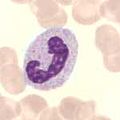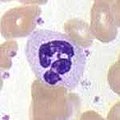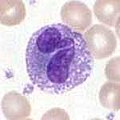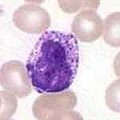Granulocyte
Granulocyte (singular: 'the granulocyte'; from Latin granulum 'granule' and ancient Greek κύτος cýtos, German 'cavity'), also polymorphonuclear leukocytes (from ancient Greek πολύ poly, German 'many', ancient Greek μορφή morphe, German 'Gestalt', Ancient Greek λευκός leukós, German 'white' and Ancient Greek κύτος cýtos, German 'cavity, vessel, envelope') and formerly also called granular leukocytes, are certain white blood cells. They make up 45 to 75% of all white blood cells (leukocytes).
There are neutrophils, basophils and eosinophils granulocytes, which are described and subdivided according to the staining behavior of the cytoplasm and have different functions. Their main task is the non-specific fight (innate immune response) against bacteria, parasites and fungi. Some granulocytes are able to absorb pathogens and destroy them. These granulocytes are therefore counted among the "phagocytes".
Granulocytes are formed in the bone marrow and released into the blood. They can also leave the bloodstream and migrate into the tissue. The life span of basophilic granulocytes is about seven days, that of neutrophilic granulocytes one to four days. The breakdown of granulocytes takes place in the mononuclear phagocytosis system by monocytes.
The lower reference interval limit for adults is 2,000/µl.
· 
Neutrophil granulocyte, rod-nucleated
· 
Neutrophil granulocyte, segment nucleated
· 
eosinophil granulocyte
· 
basophilic granulocyte
See also
- Macrophage
- T-lymphocyte
- B-lymphocyte
- Immune system
- Immune response
Questions and Answers
Q: What are granulocytes?
A: Granulocytes are a type of white blood cells that have granules in their cytoplasm.
Q: Why are granulocytes sometimes referred to as polymorphonuclear leukocytes?
A: Granulocytes are sometimes referred to as polymorphonuclear leukocytes because of the shape of their nucleus, which has three segments.
Q: Which type of granulocyte is the most abundant?
A: Neutrophils are the most abundant type of granulocyte.
Q: Where are granulocytes released from?
A: Granulocytes are released from the bone marrow.
Q: How do granulocytes operate?
A: Granulocytes operate by phagocytosis and various other means.
Q: What is the function of granulocytes?
A: The function of granulocytes is to fight infections and immunity responses.
Q: What are the characteristics of granulocytes?
A: Granulocytes are a type of white blood cells, have granules in their cytoplasm, and have a multi-segmented nucleus shape.
Search within the encyclopedia